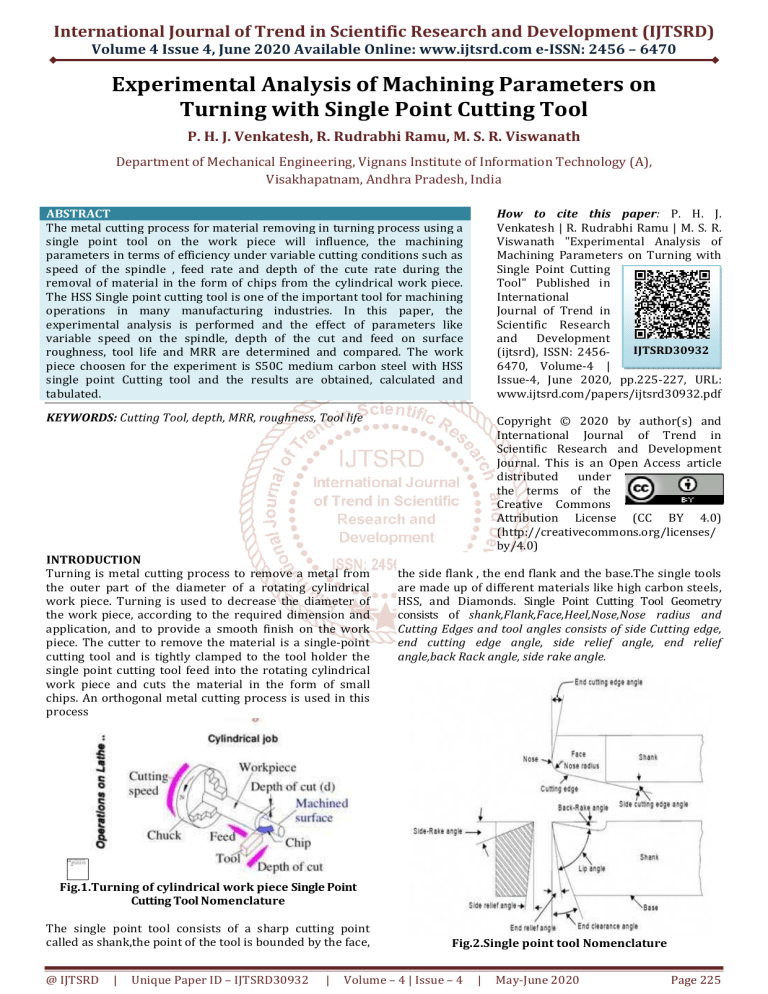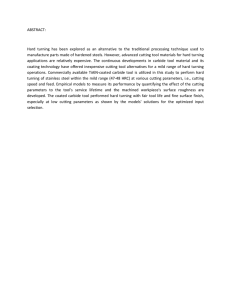
International Journal of Trend in Scientific Research and Development (IJTSRD)
Volume 4 Issue 4, June 2020 Available Online: www.ijtsrd.com e-ISSN:
ISSN: 2456 – 6470
Experimental Analysis off Machining Parameters on
Turning with
with Single Point Cutting Tool
P. H. J. Venkatesh, R. Rudrabhi Ramu, M. S. R. Viswanath
Department of Mechanical Engineering, Vignans Institute of Information Technology (A),
(A)
Visakhapatnam, Andhra Pradesh, India
ABSTRACT
The metal cutting process for material removing in turning process using a
single point tool on the work piece will influence, the machining
parameters in terms of efficiency under variable cutting conditions such as
speed of the spindle , feed rate and depth
de
of the cute rate during the
removal of material in the form of chips from the cylindrical work piece.
The HSS Single point cutting tool is one of the important tool for machining
operations in many manufacturing industries. In this paper, the
experimental
tal analysis is performed and the effect of parameters like
variable speed on the spindle, depth of the cut and feed on surface
roughness, tool life and MRR are determined and compared. The work
piece choosen for the experiment is S50C medium carbon steel with HSS
single point Cutting tool and the results are obtained, calculated and
tabulated.
How to cite this paper:
paper P. H. J.
Venkatesh | R. Rudrabhi Ramu | M. S. R.
Viswanath "Experimental Analysis of
Machining Parameters on Turning with
Single Point Cutting
Tool" Published in
International
Journal of Trend in
Scientific Research
and Development
IJTSRD30932
(ijtsrd),
jtsrd), ISSN: 24562456
6470, Volume-4
Volume
|
Issue-4,
4, June 2020, pp.225-227,
pp.225
URL:
www.ijtsrd.com/papers/ijtsrd30932.pdf
KEYWORDS: Cutting Tool, depth, MRR, roughness, Tool life
Copyright © 2020
20
by author(s) and
International Journal of Trend in
Scientific Research and Development
Journal. This is an Open Access article
distributed
ibuted
under
the terms of the
Creative Commons
Attribution License (CC BY 4.0)
(http://creativecommons.org/licenses/
by/4.0)
INTRODUCTION
ove a metal from
Turning is metal cutting process to remove
the outer part of the diameter of a rotating cylindrical
work piece. Turning is used to decrease the diameter of
the work piece, according to the required dimension and
application, and to provide a smooth finish on the work
piece. The cutter to remove the material is a single-point
cutting tool and is tightly clamped to the tool holder the
single point cutting tool feed into the rotating cylindrical
work piece and cuts the material in the form of small
chips. An orthogonal metal cutting process is used in this
process
the side flank , the end flank and the base.The
base.
single tools
are made up of different materials like high carbon steels,
HSS, and Diamonds. Single Point Cutting Tool Geometry
consists of shank,Flank,Face
Face,Heel,Nose,Nose radius and
Cutting Edges and tool angles consists of side
s
Cutting edge,
end cutting edge angle, side
s
relief angle, end relief
angle,back Rack angle,, side rake angle.
The image part with
relationship ID rId14
was not found in the
file.
Fig.1.Turning of cylindrical work piece Single Point
Cutting Tool Nomenclature
The single point tool consists of a sharp
shar cutting point
called as shank,the
he point of the tool is bounded by the face,
face
@ IJTSRD
|
Unique Paper ID – IJTSRD30932
30932
|
Fig.2.Single point tool Nomenclature
Volume – 4 | Issue – 4
|
May-June 2020
Page 225
International Journal of Trend in Scientific Research and Development (IJTSRD) @ www.ijtsrd.com eISSN: 2456-6470
PARAMETERS EVALUATED USING TURNING PROCESS
The experiment is conducted by considering HSS[2] single
point tool operating on S50Cmedium carbon steel work
piece in turning process.These machining test is
performed on a conventional lathe machine. The work
piece of cylindrical shape having a diameter of 30mm and
a length of 350mm. A Lathe machine with a spindle speed
range from 200rpm to 700 rpm was used for the
machining.The machining center was driven with 6.5 kw
electric motor.
The experiment is performed under the dry machining
environment.The tool life can be determined by
mathematical relation for calculation of total length of
effective cut.The tool life data is collected for each of the
different cutting conditions and tabulated.
S50C medium carbon steel composition:
Table.1.S50C composition
Grade
C
Mn
p
si
s
S50C 0.47-0.53 0.60-0.90 0.030 0.15-0.35 0.035
S50C grade carbon steel is widely used in machine
manufacturing, mechanical parts such as springs, gears,
tension bars, the rollers, the axis, and the load spindle.
Table 2.Process parameters of turning process
LEVEL
S.NO
PARAMETERS
1
2
3
1.
Spindle speed N, rev/min 250 450 650
2.
Feed rate f, mm/rev
0.4 0.8 1.2
3.
Depth of cut d, mm
0.5
1
1.5
Ra
MRR
N
f
d
VC
Theoretical Surface Roughness in (μm)
Material Remove Rate in cm3/min
Spindle speed in rpm
feed rate in mm/rev
depth of cut in mm
Cutting speed in m/min
Diameter of the work piece
D = 0.03m
Length of the work piece,
L= 0.35m
For 250 rpm,
Cutting speed in m/min
VC= π × D × N
1000
π × 0.03 × 250 =0.2356 m/min
=
1000
Theoretical Surface Roughness in (μm)
Ra=
=
f2
×103
8× r
0 .4 × 0 . 4
× 10 3 =25μm
0.8 × 0.8
Material Remove Rate in cm3/min
MRR
= VC × d × f
= 0.2356×0.5×0.4=0.05 cm3/min
Tool life (seconds)
The effect of cutting parameters on cutting force, tool life
and surface finish are evaluated and tabulated.
Theoretical calculations for the experimental values [1]
Consider,
FC
Cutting force in N
TL
Tool life (seconds)
TL = 60 × D
2× f × N
= 60 × 300 =210 Seconds
0 . 4 × 250
Similar way for all other calculations are done and
tabulated in the following table 3.
RESULT AND DISCUSSION
Table.3. Experimental value of different parameters of turning process
@ IJTSRD
|
S.NO
N
f
d
Fc
VC
Ra (μm)
TL
MRR
1.
250
0.4
0.5
490
0.235
25
210
0.05
2.
250
0.8
1
1672
0.235
25
105
0.19
3.
250
1.2
1.5
2340
0.235
25
70
0.42
4.
450
0.4
0.5
490
0.424
100
116
0.08
5.
450
0.8
1
1672
0.424
100
59
0.34
6.
450
1.2
1.5
2340
0.424
100
38
0.76
7.
650
0.4
0.5
490
0.612
225
81
0.12
8.
650
0.8
1
1672
0.612
225
40
0.49
9.
650
1.2
1.5
2340
0.612
225
27
1.10
Unique Paper ID – IJTSRD30932
|
Volume – 4 | Issue – 4
|
May-June 2020
Page 226
International Journal of Trend in Scientific Research and Development (IJTSRD) @ www.ijtsrd.com eISSN: 2456-6470
Graphs
0.80
Vc in m/min
0.70
0.60
0.50
0.40
0.30
0.42
0.24
0.24
0.24
0.20
0.10
0.00
TL in min
0
0.5
1
1.5
2
2.5
3
3.5
4
Fig.3. TL varied with VC
250
225
REFERENCES
[1] Kapil Sharma, Dalgobind Mahto, Sen S S. In Metal
Turning, Effect of Various Parameters on Cutting
Tool: A Review- International Journal of Application
or Innovation in Engineering & Management
(IJAIEM), Aug 2013, 2(8), 32-38.
200
150
VC
100
100
50
[2] Wear Analysis of Single Point Cutting Tool With and
Single Point Cutting Tool with and without
Coating:Nitin
M
Mali,T.Mahender
IJREAT
International Journal of Research in Engineering &
Advanced Technology, Volume 3, Issue 3, June-July,
2015.
25
0
0
0.2
0.4
0.6
0.8
RA
[3] Effects of single point cutting tool materials on tool
work interface and cutting performance using
FEAS:Arun Prasath , Ankit Kumar , Hemanta Deka
and Abhishek Lahkar:IOP Conf. Series: Materials
Science and Engineering 402 (2018) 012133
doi:10.1088/1757-899X/402/1/012133.
MRR in cub cm/min
Fig.4. Ra varied with VC
1.4
1.1
1.2
1
0.8
0.6
[4] PNRAO, “Metal cutting and machine tools”, Text book
of Tata Mech Grawhill publications, Vol.2, 3rd
Edition, 2013.
0.34
0.4
0.12
0.2
0
0
0.5
1
CONCLUSION
The results obtained shows the variable changes on all
machining parameters such a high depth and feed rate the
effect on the MRR increased with the increase in feed rate
of the cut and when cutting speed value is increased the
MRR value is also increased it clearly shows that when
there is increase in the spindle speed the material rate is
increased and tool life time varied with the cutting speed
also. The surface roughness value increased with high
cutting speed. The experiment further can be conducted
on different materials of single point tool in presence of
coolant for better results than obtained as this experiment
was conducted in the dry environment and with the same
considerations the above experiment can be conducted
with the CNC Lathe with a correct correlation of machining
parameters with correct material of single point tool can
be choosen to reduce the loss of energy and better
finishing of
work piece.
1.5
2
Vc
[5] D. A. Axinte, W. Belluco, L. De Chiffre ,“Evaluation of
cutting force uncertainty components in Turning”
International Journal of Machine Tools &
Manufacture 41, 2001, pp. 719–730,.
MRR in cub cm/min
Fig.5. MRR varied with Vc
1.4
1.1
1.2
1
0.8
0.6
0.34
0.4
0.12
0.2
0
0
0.5
1
1.5
2
Depth of cut in mm
Fig.6.MRR varied with depth of cut
@ IJTSRD
|
Unique Paper ID – IJTSRD30932
|
Volume – 4 | Issue – 4
|
May-June 2020
Page 227




